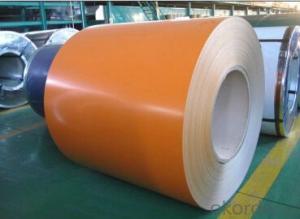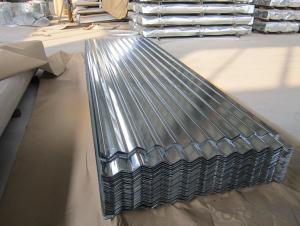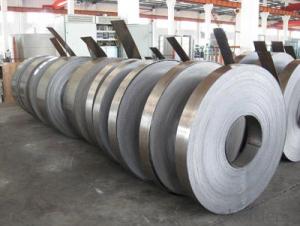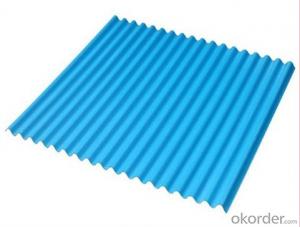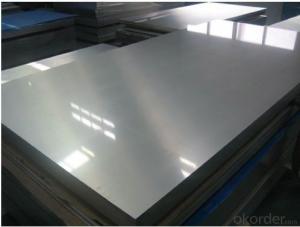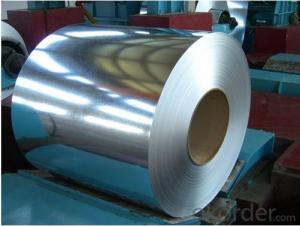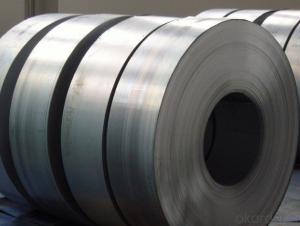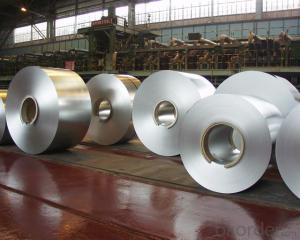PPGI Prepainted Galvanized steel Coil ASTM 615-009
- Loading Port:
- Tianjin
- Payment Terms:
- TT OR LC
- Min Order Qty:
- 22 kg/m²
- Supply Capability:
- 11 kg/m²/month
OKorder Service Pledge
OKorder Financial Service
You Might Also Like
1.Structure of Prepainted Galvanized steel Coil :
With Gi as base metal,after pretreatmet (degrease and chemical treatment) and liquid dope with several Layers of color,then after firing and cooling,finally the plate steel is called pre-painted galvanized steel ( PPGI) .Pre-painted galvanized steel is good capable of decoration ,molding,corrosion resistance lowering the cost of production and increasing the quality of the metal. Today, steel is one of the most common materials in the world, with more than 1.3 billion tons produced annually. It is a major component in buildings, infrastructure, tools, ships, automobiles, machines, appliances, and weapons. Modern steel is generally identified by various grades defined by assorted standards organizations.
2.Main Features of Prepainted Galvanized steel Coil:
• Excellent process capability
• Smooth and flat surface
• Workability, durability
• Excellent heat resistance performance
• High strength
• Good formability
• Good visual effect
3.Prepainted Galvanized steel Coil Images

4.Prepainted Galvanized steel Coil Specification
Community portal – Bulletin board, projects, resources and activities covering a wide range of Wikipedia areas.
Help desk – Ask questions about using Wikipedia.
Local embassy – For Wikipedia-related communication in languages other than English.
Reference desk – Serving as virtual librarians, Wikipedia volunteers tackle your questions on a wide range of subjects.
Site news – Announcements, updates, articles and press releases on Wikipedia and the Wikimedia Foundation.
Village pump – For discussions about Wikipedia itself, including areas for technical issues and policies.
C | Si | Mn | Cr | Ni | P | S |
0.150 | 0.476 | 11.231 | 12.50 | 0.900 | 0.039 | 0.010
|
5.FAQ of Prepainted Galvanized steel Coi
We have organized several common questions for our clients,may help you sincerely:
1.How do you control your quality
We have established the international advanced quality management system,every link from raw material to final product we have strict quality test;We resolutely put an end to unqualified products flowing into the market. At the same time, we will provide necessary follow-up service assurance.
2.how long we will receive the goods ?
After receiving your deposit or workable lc ,our normal shipment date is 15-20days,and it takes around 28 days to reach your port of destination. But is up to different destination The bar-throated minla (Minla strigula) is a species of bird found in the montane forests of the Indian subcontinent and Southeast Asia.
3. what is your moq
Normally our moq is 25per size ,but it is up to different size
- Q:How are steel strips processed further for specific applications?
- Various techniques and methods are utilized to further process steel strips for specific applications. Cold rolling is a commonly used method where the strips are passed through a series of rollers at room temperature to reduce thickness and enhance surface finish. This procedure also improves the mechanical properties of the steel, including strength and hardness. After cold rolling, steel strips can undergo annealing, which involves heating them to high temperatures and gradually cooling them. This helps to alleviate internal stresses, enhance ductility, and refine the grain structure of the steel, resulting in better suitability for specific applications. Coating is another essential step in steel strip processing. Depending on the intended use, the strips can be coated with materials such as zinc, aluminum, or polymer to provide protection against corrosion, improve aesthetics, and enhance performance in specific environments. Furthermore, steel strips can be subjected to various forming processes, such as bending, stamping, or deep drawing, to shape them into specific components or products. These forming techniques enable the transformation of steel strips into a wide range of applications, including automotive parts, construction materials, electrical appliances, and packaging materials. Additionally, secondary operations such as slitting, edging, and shearing may be conducted to further refine the dimensions and characteristics of the steel strips for specific applications. These secondary processes aid in achieving the desired size, shape, and surface quality required by different industries. In conclusion, steel strips undergo further processing through cold rolling, annealing, coating, forming, and secondary operations to customize their properties and dimensions for specific applications. These processing techniques are crucial in optimizing the performance, functionality, and versatility of steel strips in various industries.
- Q:How are steel strips protected during storage and shipment?
- Steel strips are typically protected during storage and shipment through a variety of measures. This includes applying a protective coating or oil to prevent corrosion, using rust-resistant packaging materials such as plastic or paper, and ensuring proper stacking and secure strapping to prevent damage or shifting during transit. Additionally, climate-controlled storage facilities may be utilized to maintain optimal conditions and prevent moisture-related issues.
- Q:Can steel strips be used for making furniture?
- Yes, steel strips can be used for making furniture. Steel strips are commonly used for furniture frames, particularly in modern and industrial-style designs. They are strong, durable, and can support heavy loads. Steel strips can be shaped and welded together to create various furniture pieces such as chairs, tables, and shelves. Additionally, steel strips can be powder-coated or painted to provide a decorative finish and protection against rust and corrosion. Overall, steel strips are a versatile material that can be used effectively in furniture manufacturing.
- Q:How do steel strips contribute to reducing product weight in various applications?
- Steel strips contribute to reducing product weight in various applications by providing a lightweight alternative to solid steel components. Due to their thin and narrow form, steel strips can be used in place of thicker and bulkier steel materials, resulting in reduced overall weight without compromising strength or structural integrity. These strips are versatile and can be easily formed, shaped, or cut according to specific requirements, making them suitable for a wide range of applications such as automotive, aerospace, and construction industries. Additionally, steel strips are also highly corrosion-resistant, which further enhances their longevity and reliability in different environments.
- Q:What are the dimensional inspection methods for steel strips?
- Steel strips commonly undergo dimensional inspections using various methods to ensure their accuracy and conformity to specified standards. Some commonly employed methods for this purpose include: 1. Calipers: These instruments directly measure the thickness, width, and length of steel strips by comparing them with the calibrated scale on the caliper. This provides precise measurements. 2. Micrometers: Precision instruments like micrometers accurately measure the thickness and width of steel strips, even up to the micrometer level. They offer highly accurate measurements. 3. Optical comparators: By magnifying and illuminating the steel strip, optical comparators enable a visual comparison with a reference standard. This method allows the inspection and measurement of dimensions like width, length, and shape. 4. Laser measurement: Laser measurement systems utilize laser beams to accurately measure dimensions such as width, thickness, and more without physical contact. This ensures high precision and speed. 5. Coordinate measuring machine (CMM): CMMs are automated and highly precise dimensional inspection methods. They utilize a probe to measure multiple dimensions, including length, width, thickness, and complex geometries. CMMs provide accurate measurements for various steel strip profiles. 6. Vision systems: Vision systems incorporate cameras and image processing algorithms to inspect dimensions like width, length, and thickness of steel strips. They can also detect surface defects or irregularities. These dimensional inspection methods are often used in combination to obtain comprehensive and accurate measurements of steel strips. The selection of the appropriate method depends on the specific requirements, desired accuracy, and the type of steel strip being inspected.
- Q:How are steel strips used in the production of electrical connectors?
- Steel strips are used in the production of electrical connectors to provide structural support and enhance conductivity. They are commonly used as a base material for connectors, allowing for secure attachment of wires and cables. Additionally, steel strips are often utilized for creating contact springs, which ensure reliable electrical contact between the connector and the connected device.
- Q:What are the main quality standards for steel strips?
- The main quality standards for steel strips include factors such as dimensional accuracy, surface finish, mechanical properties (such as tensile strength and hardness), chemical composition, and uniformity throughout the strip. These standards ensure that steel strips meet the required specifications for various applications and industries, ensuring reliable and consistent performance.
- Q:How are steel strips processed for surface bending?
- Various methods are employed to process steel strips for surface bending. The initial step in the process involves selecting the appropriate steel grade and thickness for the desired application. Once the steel strips have been chosen, they undergo cleaning and preparation before bending. Roll forming machines are commonly utilized to bend the surface of steel strips. These machines consist of a series of rollers that gradually shape the strip into the desired form. The strip is fed through the machine, and each roller applies a small amount of force, gradually bending the strip. This process enables precise and consistent bending. Another approach to surface bending is press braking. This technique involves the use of a hydraulic or mechanical press to bend the strip. The strip is positioned between a punch and a die, and pressure is applied, causing the strip to bend. Press braking is suitable for both small and large bends, and it allows for the formation of more intricate shapes. In some instances, heat is applied to aid in the bending process, known as hot bending. This method is typically used for thicker steel strips. The strip is heated to a specific temperature and then shaped into the desired form. The heat softens the steel, making it more malleable and easier to bend. Following the surface bending process, the steel strips may undergo additional treatments such as annealing or tempering to enhance their strength and durability. These treatments help to eliminate internal stresses caused by bending and improve the overall performance of the steel. In conclusion, steel strips can be processed for surface bending using various methods, including roll forming, press braking, and hot bending. The selection of the technique depends on factors such as the desired shape, strip thickness, and specific application requirements.
- Q:How are steel strips processed for load-bearing capacity?
- Steel strips are processed for load-bearing capacity through a series of manufacturing and treatment processes. The first step in enhancing load-bearing capacity is the selection of the appropriate grade of steel. Different grades of steel have varying mechanical properties, such as yield strength and tensile strength, which directly impact load-bearing capacity. Higher strength grades, such as high-strength low-alloy (HSLA) or advanced high-strength steel (AHSS), are typically chosen for applications requiring greater load-bearing capacity. Once the steel grade is determined, the steel strips undergo a series of manufacturing processes. The strips are usually hot-rolled or cold-rolled to achieve the desired thickness and shape. Hot-rolling involves heating the steel above its recrystallization temperature and passing it through a series of rollers to reduce thickness and shape it into a strip. Cold-rolling, on the other hand, involves passing the steel through rollers at room temperature, resulting in a smoother finish and tighter tolerances. After the initial rolling process, the steel strips may undergo further treatments to enhance their load-bearing capacity. One common treatment is heat treatment, which involves heating the steel to a specific temperature and then rapidly cooling it to alter its microstructure. This process can increase the strength and hardness of the steel, improving its load-bearing capacity. Other treatments may include surface coatings or galvanization to protect the steel from corrosion, which can weaken its load-bearing capacity over time. Coatings such as zinc or epoxy can provide an extra layer of protection against environmental factors that may compromise the integrity of the steel strips. In summary, steel strips are processed for load-bearing capacity by selecting the appropriate grade of steel, followed by manufacturing processes such as hot-rolling or cold-rolling. Additional treatments like heat treatment and surface coatings may be applied to further enhance the load-bearing capacity and protect the steel from corrosion.
- Q:Are steel strips suitable for the production of roofing materials?
- Yes, steel strips are suitable for the production of roofing materials. Steel is durable, strong, and resistant to weathering, making it an excellent choice for roofing. Additionally, steel can be easily shaped into various profiles and coated with protective finishes to enhance its longevity and aesthetic appeal.
1. Manufacturer Overview |
|
|---|---|
| Location | |
| Year Established | |
| Annual Output Value | |
| Main Markets | |
| Company Certifications | |
2. Manufacturer Certificates |
|
|---|---|
| a) Certification Name | |
| Range | |
| Reference | |
| Validity Period | |
3. Manufacturer Capability |
|
|---|---|
| a)Trade Capacity | |
| Nearest Port | |
| Export Percentage | |
| No.of Employees in Trade Department | |
| Language Spoken: | |
| b)Factory Information | |
| Factory Size: | |
| No. of Production Lines | |
| Contract Manufacturing | |
| Product Price Range | |
Send your message to us
PPGI Prepainted Galvanized steel Coil ASTM 615-009
- Loading Port:
- Tianjin
- Payment Terms:
- TT OR LC
- Min Order Qty:
- 22 kg/m²
- Supply Capability:
- 11 kg/m²/month
OKorder Service Pledge
OKorder Financial Service
Similar products
New products
Hot products
Hot Searches
Related keywords
